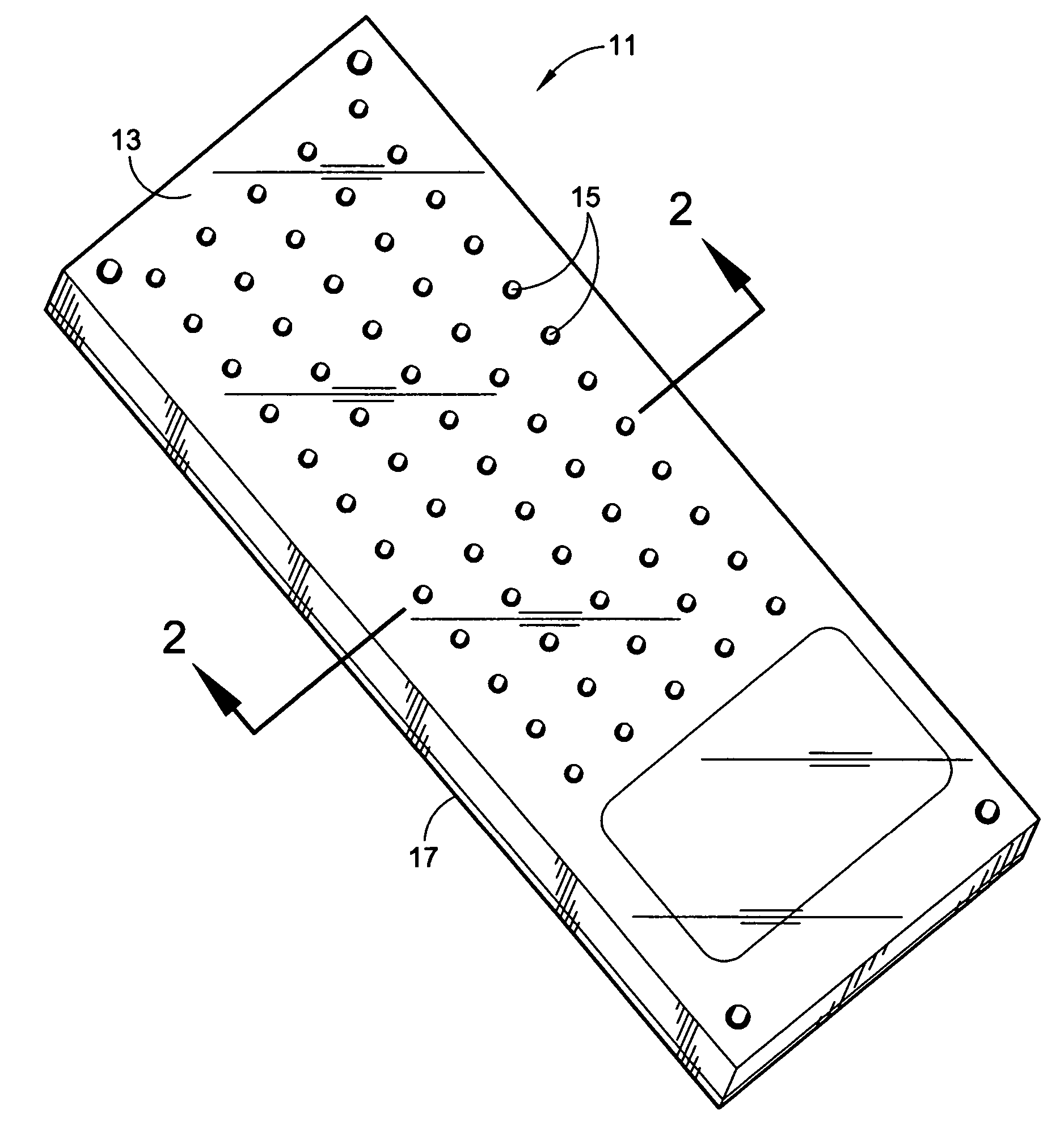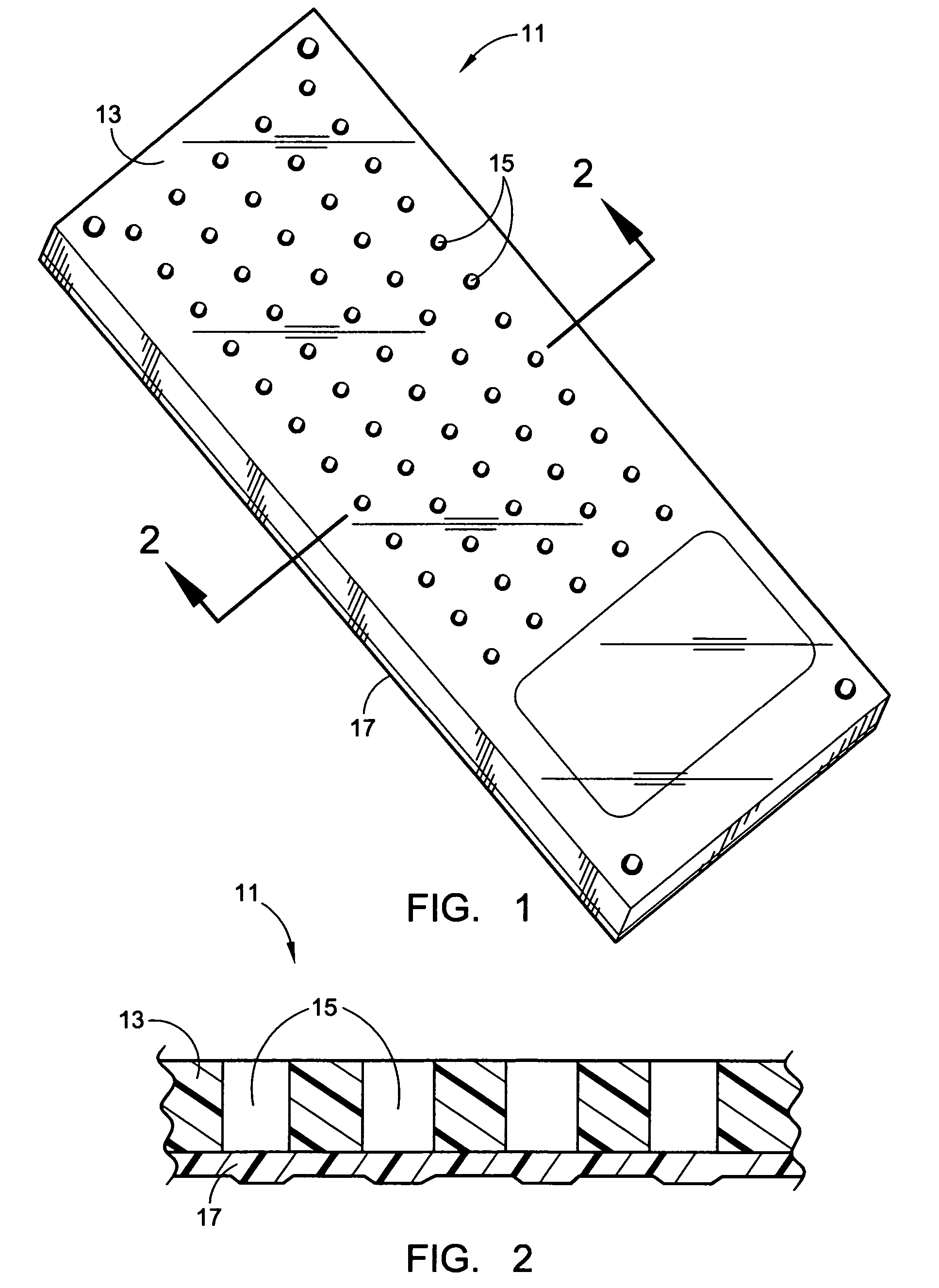Microwell biochip
a microwell and biochip technology, applied in the field of microwell biochips, can solve the problems of optically obtaining accurate quantitative assays, fluid handling difficulties, and additional costs of producing such high density microtiter plates, and achieve the effects of high throughput assay capabilities, simple and versatile forma
- Summary
- Abstract
- Description
- Claims
- Application Information
AI Technical Summary
Benefits of technology
Problems solved by technology
Method used
Image
Examples
example 1
Preparation of Microwell Biochips
[0026]A sample microwell biochip 11 was advantageously designed to be similar in size and shape to a common (2.54×7.62 cm) microscope slide. Sixty 1.3 mm diameter holes 15 were drilled through a black polycarbonate plate 13 about 1 mm thick using a standard microtiter plate configuration (e.g. 4.5 mm pitch). In order to further decrease background during optical scanning, the plate was spray painted (prior to lamination) to give it a matte black finish.
[0027]A 0.45 μm pore size polypropylene membrane 17 (Osmonics, Inc., Minnetonka, Minn.) was laminated to the undersurface of the plate by applying spray-on adhesive to the plate and pressing the membrane in place to create this sample multiwell chip; however, it should be understood that ultrasonic welding is preferred. The membrane 17 exhibited a smooth hydrophobic surface, thus ensuring good spot morphology. This small pore membrane retains aqueous samples in the wells during binding / hybridization ev...
example 2
Printing and Hybridizing with a Microwell Protein Biochip
Protein Formulations for Printing
[0028]A mixture of Anti-transferrin antibody in Hypol (Hampshire Chemical Corporation, Lexington, Mass.) and nonspecific IgG in Hypol (as blank control) were printed and then tested with Cy3-labeled transferrin. HYPOL is an isocyanate-capped PEG prepolymer that is believed to be well-suited for this application. Both samples were formed as 3.3 weight % solutions of HYPOL (1:3:3=Prepolymer:Acetonitrile:NMP), which contained 5% Trehalose (protein preservative sugar), 100 mg / ml IgG (protein filler), 0.5% Glycerol (humectant), and either 0.8 mg / ml anti-transferrin (positive) or 1 mg / ml Bovine IgG (negative).
Printing
[0029]Printing was performed using a Cartesian array printing system (Cartesian Technologies, Inc., Irvine, Calif.) and 300 micron inside diameter glass capillary pins (Humagen Fertility Diagnostics, Inc., Charlottesville, Va.). Hydrogel spots having an approximately 310 micron diameter ...
example 3
Imaging
[0031]In order to measure the fluorescence of microwell biochip, a charge-coupled device-based scanner was constructed using a CCD camera. Even though current dimensions of the chip allow for scans in a conventional microarray laser scanner, a CCD camera offers greater flexibility in terms of depth of focus, thickness and width of the chip. In the embodiment employed, the chip was placed on a movable stage with the CCD camera positioned directly above. Excitation light, provided by a halogen bulb, passes through a dichroic mirror, and the emission light is collected by the CCD. The dichroic mirror is set to collect data in the Cy3 fluorescent dye range. A variety of other dichroics can be substituted into the camera, thus allowing a choice from a wide range of dyes, e.g. fluorescein, Cy5. The stage can be moved either manually or through programming of different scan coordinates into the camera software. Focus, camera sensitivity, and camera exposure times are varied as neces...
PUM
| Property | Measurement | Unit |
|---|---|---|
| pore size | aaaaa | aaaaa |
| thickness | aaaaa | aaaaa |
| thick | aaaaa | aaaaa |
Abstract
Description
Claims
Application Information
 Login to View More
Login to View More - R&D
- Intellectual Property
- Life Sciences
- Materials
- Tech Scout
- Unparalleled Data Quality
- Higher Quality Content
- 60% Fewer Hallucinations
Browse by: Latest US Patents, China's latest patents, Technical Efficacy Thesaurus, Application Domain, Technology Topic, Popular Technical Reports.
© 2025 PatSnap. All rights reserved.Legal|Privacy policy|Modern Slavery Act Transparency Statement|Sitemap|About US| Contact US: help@patsnap.com


